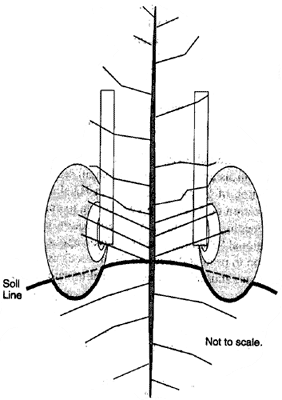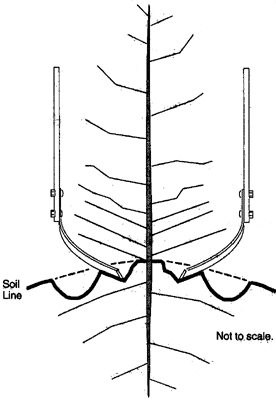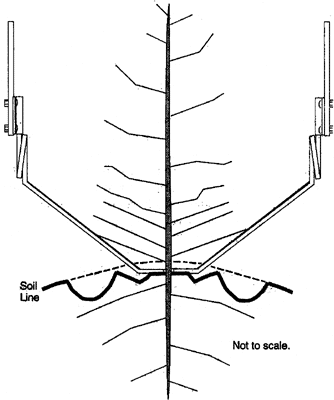How to Mechanically Remove Weeds From the Row
by Gary W. Thacker and Wayne E. Coates
Abstract
This article offers practical advice on in-row, weeding techniques and tooling set-ups.
Introduction
Before soil incorporated herbicides became available in the 1960's, cotton farmers relied heavily on mechanical in-row weeding and hand labor to control weeds. Cultivations were slow, meticulous operations with front mounted cultivators on open tractors. Such operations are not feasible today because front mounted cultivators are too unwieldy and slow to be cost effective. Concerns about hand weeding costs, herbicide-resistant weeds, herbicide carry-over, and groundwater pollution have renewed farmers' interest in using steel to kill weeds. Machine guidance systems offer the precision that mechanical in-row weeding demands, while allowing high travel speeds and greater productivity (Kocher, et al. 1994; Thacker and Coates, 1995).
Poor weed control in the crop or seed row is the major shortcoming of current cultivation practices and implements. While some small weeds in the row can be controlled by covering them with soil, this is not completely effective. This article discusses mechanical in-row weeding which we have successfully used in our precision cultivator tests.
Tooling for Mechanical In-Row Weeding:
Figures 1 to 3 depict a typical cotton bed and plant profiles at the time of second or third cultivation. Dirt has already been thrown to the row up to about the first vegetative branch. For clarity of illustration, loosened soil (the fluff) is not shown, and the original soil surface is shown as a dotted line. The cotton is shown only as the main stalk, lateral branches, tap root, and lateral roots. Figures 1 to 3 depict a series of operations and tools which could be added to virtually any cultivator, and are suggestions to prompt you to think about alternative tooling arrangements. Because of the close tolerance needed, such a cultivator would be impossible to operate without an electro-hydraulic implement guidance system.
First, disks cut paths through weeds and debris (Figure 1).
The disks are not absolutely necessary for all field conditions, however we have found them to be essential in heavy stands of nutsedge and bermuda grass. The cutting and throwing action of the disks greatly reduces plugging with the tools which follow behind.
In Figure 1, the disk shanks are six inches apart. That is about as close as the disks can be operated without damaging cotton as large as that shown in the figure. We tried using shields to funnel the cotton through a narrower area; but had trouble with large clods, wood, and other debris lodging between the shields.
An alternative arrangement is to orient the disks to throw soil toward the row. This "dirting" ahead of the other tools is not detrimental to their operation, and is gentler in large cotton, because the disks act as funnels for the cotton to pass through.

Figure 1. Disks cutting paths through weeds and debris. These
disks can be oriented to throw soil toward or away from the row.
Second, fixed knives shear soil beneath the cotton canopy (Figure 2).
The knives follow the disks, and are turned in towards the row. We used crescent hoes, however knives such as beet hoes or vegetable top knives should work as well. To avoid cutting off cotton roots, the knives should be run no deeper than the seeding depth. Gauge wheels are essential to maintain a safe height.
There are two reasons for the inward orientation of the knives. The first is to reach under the canopy and cut off large weeds that would otherwise be missed. This helps capitalize on the high precision possible with an implement guidance system.
The second reason is to facilitate operation of the in-row weeding devices. These spring steel elements do not work well when positioned directly behind disks, because the disks leave hard, smooth soil edges that the weeders must crumble in order to uproot weeds in the row. Fixed knives leave ragged edges of soil that are much easier to crumble.

Figure 2. Fixed knives shearing soil beneath the cotton canopy.
This inward orientation capitalizes on the high precision possible
with an electro-hydraulic implement guidance system, while facilitating
the operation of in-row weeding devices by leaving ragged edges
of soil which are easy to crumble.
Third, weeders crumble the soil and uproot weeds in the row (Figure 3).
The in-row weeders till (crumble) the small strip of soil which was left undisturbed between the knives. This action uproots weed seedlings in the row between cotton plants without harming the cotton. The aggressiveness of the weeders can be adjusted as needed, and will vary with crop size and soil conditions. Large cotton can tolerate very aggressive in-row weeding, which will kill virtually all weed seedlings and even some larger weeds.
The weeders shown in Figure 3 are Bezzerides "torsion weeders", which are essentially spring steel rods which move in and out of the row crumbling the soil. They also move up and down to some extent. Bezzerides "spring hoe" weeders could also be used. These tools should run no deeper than cotton seeding depth.

Figure 3. In-row weeders crumble soil and uproot weeds in the
row
Finally, run the rest of the cultivator as you normally would, including "dirting" the row.
Mechanical in-row weeding can be combined with herbicide applications to provide effective control of annual morningglory species and other weeds. A generalized program for morningglory control could include the following:
- Pre-plant application of pendimethalin (Prowl) or trifluralin (Treflan) to stunt or suppress early emerging morningglory. This also controls annual grasses and small seeded broadleaf weeds.
- Over-the-top band application of Staple (or Buctril on BXN cotton) on very small cotton (1 to 4 leaf) or "sloppy" post-direct application on 5-leaf or bigger cotton to control early emerging morningglory.
- Use mechanical in-row weeding techniques to protect cotton from weeds until lay by. Mechanical in-row weeding can replace traditional "chemical hoe" herbicide applications.
- Layby herbicide application to protect the cotton from weeds as the row close.
- Spot treatment with herbicides and/or hand weeding to eliminate seed production and reduce weed pressure in future years.
Acknowledgments
This project was supported by a grant from the U.S. Environmental Protection Agency through the Arizona Department of Environmental Quality. The authors also appreciate the support and cooperation of Marwald West, Inc., Fleischer Manufacturing, Bezzerides Brothers, Inc., UA Extension Weed Specialist Bill McCloskey, and the several county agents and cotton farmers who made our field demonstrations successful.
References
- Kocher, M.F., M.B. Smith, R.D. Grisso, and L.J. Young. 1994. Performance Comparison for Two Types of Implement Guidance Systems. Paper No.94-3574, ASAE International Winter Meeting, 13-16 Dec. 1994, Atlanta, GA. ASAE, 2950 Niles Rd, St. Joseph, MI 49085-9659.
- Thacker, G. W., and W.E. Coates. 1995. Precision Guidance Techniques to Reduce Weed Competition and Production Costs in Cotton. Cotton, A College of Agriculture Report. The University of Arizona, Series P-99:224- 233.
Issued in furtherance of Cooperative Extension work, acts of May 8 and June 30, 1914, in cooperation with the U.S. Department of Agriculture, James A. Christenson, Director Cooperative Extension, College of Agriculture and Life Sciences, The University of Arizona.
The University of Arizona is an equal opportunity, affirmative action institution. The University does not discriminate on the basis of race, color, religion, sex, national origin, age, disability, veteran status, or sexual orientation in its programs and activities.
Any products, services, or organizations that are
mentioned, shown, or indirectly implied in this web document do not imply
endorsement by The University of Arizona.
Information provided by:
Gary W. Thacker
Wayne E. Coates wcoates@u.arizona.edu, Research Professor, Arid Lands
College of Agriculture and Life Sciences, The University of Arizona
Material written 1996, Revised March, 2002.
Crop Mgmt | Soil Mgmt | Irrigation | Varieties | Cotton Comments
Home | Cotton | Advisories
document located at: http://cals.arizona.edu/crops/equipment/removeweed.html
Copyright © 2001 University of Arizona,
College of Agriculture and Life Sciences
Webmaster: Al Fournier (acis@ag.arizona.edu)